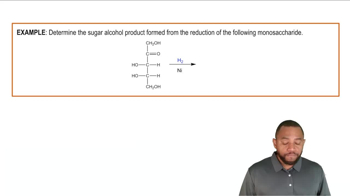Classify structures A, B, and C in the figure as being either an enantiomer or a diastereomer of d-galactose.
<IMAGE>
 Verified step by step guidance
Verified step by step guidance



Classify structures A, B, and C in the figure as being either an enantiomer or a diastereomer of d-galactose.
<IMAGE>
Use the structure of d-galactose in Problem 6.15 to answer the following:
(a) Draw the Fischer projection of the carbon 3 epimer.
Identify the monosaccharide that fits each of the following descriptions:
(a) also referred to as dextrose
ALLIED Health The sugar alcohol ribitol is a component of the vitamin riboflavin and the energy transfer molecule FAD. Ribitol is formed when the monosaccharide ribose undergoes reduction at carbon 1. Draw the structure of ribitol.
<IMAGE>
d-Ribose
ALLIED Health The sugar alcohol erythritol is often included in low-calorie sweeteners. It is 70% as sweet as table sugar. Erythritol is the reduced form of the aldotetrose erythrose. Draw erythritol.
<IMAGE>
d-Erythrose
Identify the following reactions as condensation or hydrolysis:
(a) two monosaccharides reacting to form a disaccharide